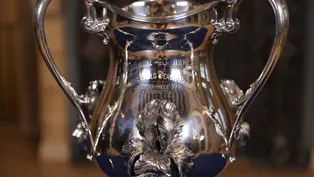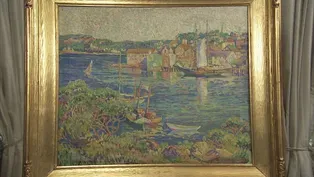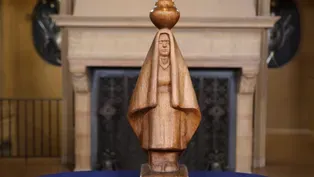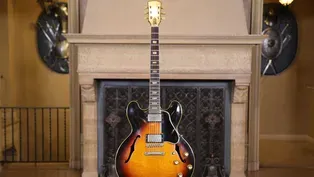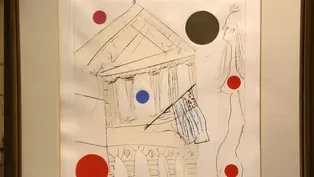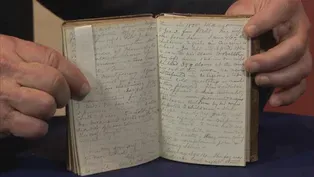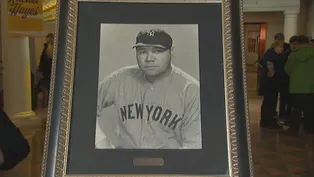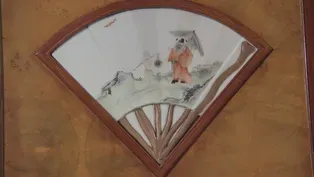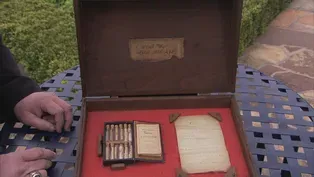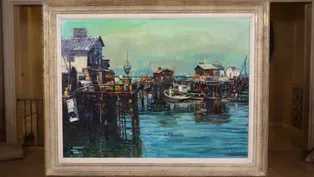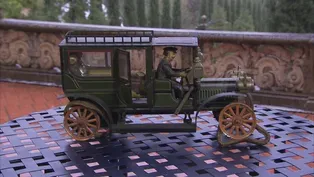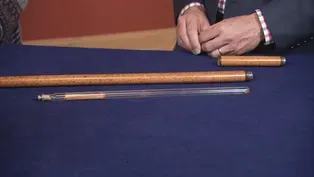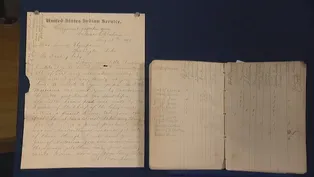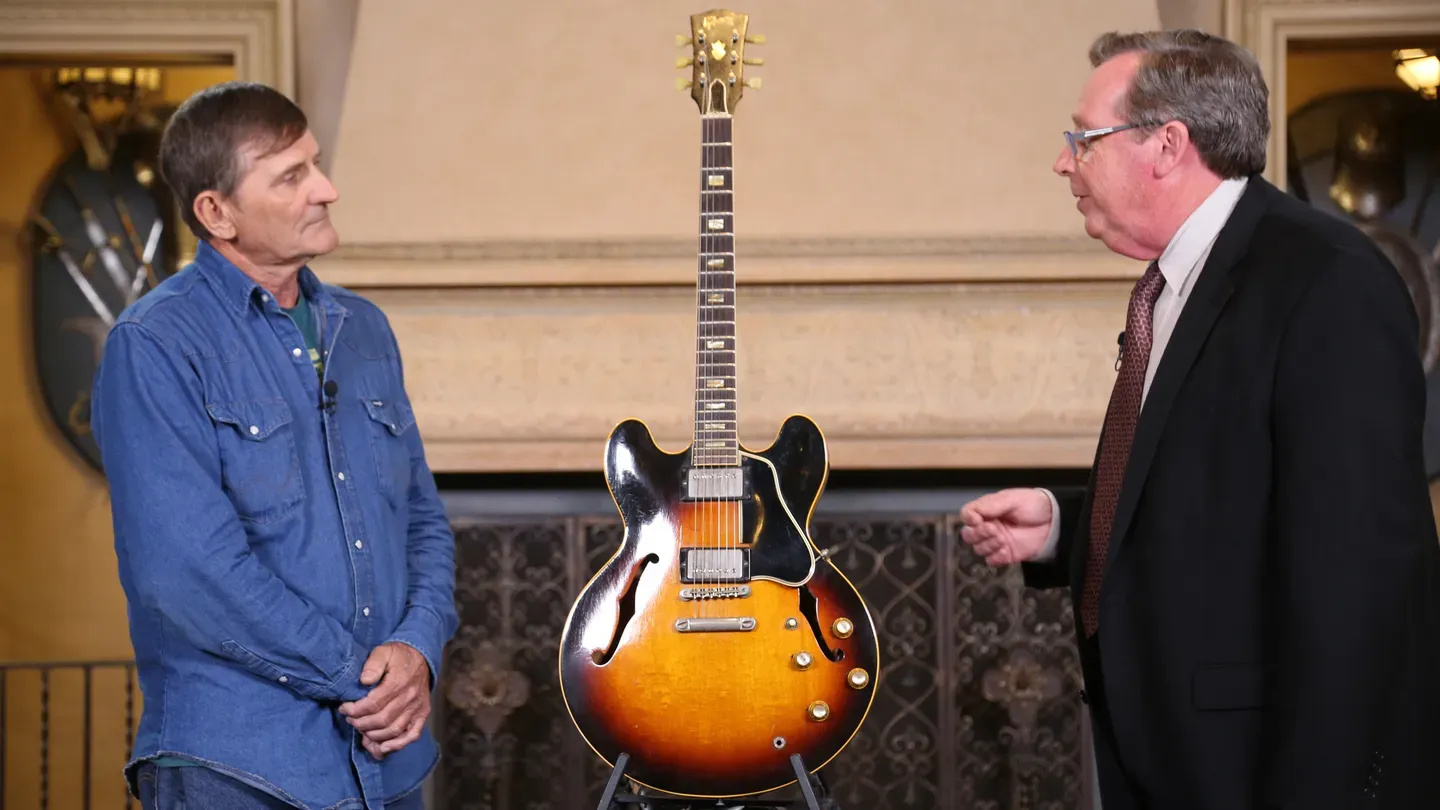

Philbrook Museum, Hour 3
Season 23 Episode 12 | 52m 29sVideo has Closed Captions
Tremendous Tulsa treasures abound with ROADSHOW at Philbrook Museum. One’s up to $30,000!
Tremendous Tulsa treasures abound when ANTIQUES ROADSHOW visits Philbrook Museum of Art, including a Dalí "The Art Institute" etching, a 1964 Frank Sinatra letter, and a Mississippian culture effigy pot, 900-1500 AD. One’s valued at $20,000-$30,000!
Problems with Closed Captions? Closed Captioning Feedback
Problems with Closed Captions? Closed Captioning Feedback
Funding for ANTIQUES ROADSHOW is provided by Ancestry and American Cruise Lines. Additional funding is provided by public television viewers.

Philbrook Museum, Hour 3
Season 23 Episode 12 | 52m 29sVideo has Closed Captions
Tremendous Tulsa treasures abound when ANTIQUES ROADSHOW visits Philbrook Museum of Art, including a Dalí "The Art Institute" etching, a 1964 Frank Sinatra letter, and a Mississippian culture effigy pot, 900-1500 AD. One’s valued at $20,000-$30,000!
Problems with Closed Captions? Closed Captioning Feedback
How to Watch Antiques Roadshow
Antiques Roadshow is available to stream on pbs.org and the free PBS App, available on iPhone, Apple TV, Android TV, Android smartphones, Amazon Fire TV, Amazon Fire Tablet, Roku, Samsung Smart TV, and Vizio.
Buy Now

ANTIQUES ROADSHOW 2025 Tour!
Enter now for a chance to win free tickets to ANTIQUES ROADSHOW's 2025 Tour! Plus, see which cities we're headed to!Providing Support for PBS.org
Learn Moreabout PBS online sponsorshipMARK WALBERG: "Antiques Roadshow" is awash in the treasures of Tulsa at the Philbrook Museum of Art.
It is a roll of the dice.
I know it.
And you look like a gambler.
I am.
(laughs) That's amazing.
Should I hug you now or later?
♪ ♪ WALBERG: The Philbrook became the first art museum in Tulsa when Waite and Genevieve Phillips donated their estate for the pursuit and preservation of art in 1938.
In addition to a significant collection of Native American art, which grew from Waite's great appreciation for Native American cultures, the Philbrook has expanded over time to include an eclectic array of works from all over the world.
Curious art and antique owners have come to "Antiques Roadshow" today from all over Oklahoma.
Let's see what they have to share.
MAN: I got this in Wisconsin about ten years ago.
There's no markings or anything.
I just have no idea what it really is, but it's a cool item.
They are not real.
They are costume pearls.
Well, I figured that.
Yes.
Knowing my mom.
They are... She keeps everything no matter how broken it is.
Yes-- they are plastic.
They're, maybe, worth around two dollars for the whole box.
Okay.
It's either between the wars or after World War II, judging by the way her hair is done.
In the world of art and antiques, the three things that sell the most are naked ladies, cats, and elephants.
So, if you had a naked lady holding a cat riding an elephant, the kids are going to college.
♪ ♪ APPRAISER: Where did you get this?
WOMAN: In Douglasville, Georgia, at a garage sale about five years ago.
And the people in the garage sale, did they tell you anything about it?
Yeah, they told me back in Japan, after the war... Mm-hmm.
...they had so many bullets left over that they melted all the bullets and started making these.
Wow, that's an interesting story.
Mm-hmm.
But it's not true.
Oh!
I mean, it is true, but it's not true for this.
Okay!
That's a good one.
The shape is based on a design from the late Meiji period-- the late 19th century, early 20th century.
But those designs continued in Japan over a longer period of time.
So I think this is maybe 1920 to 1950.
The dark color you see here on the inside is the actual color-- it's this kind of green.
Uh-huh.
Mottled green color, then over time, people with, like me have been handling it, and the oil on my hand has gone into that.
Oh, okay.
And it's affected the color, so that lovely dark green patination... Uh-huh.
...that was applied to the brass, meant to imitate bronze, has gone.
And now you get this kind of muddy, dark surface.
Okay.
So it is a less expensive, mass-produced version of a bronze vase.
This is meant to be a nice decorative object made for export to the West.
The value?
(laughs) It's gotten beat up a little bit, so it's worth about five to ten dollars at auction.
Oh, well, that's okay.
That's okay-- I only paid, like, three for it, so I'm happy.
Well, there you are!
I made a profit.
Good, good!
WOMAN: It was my grandfather's, and then he gave it to my dad, and then my dad gave it to me.
APPRAISER: And how did your grandfather get it?
He won it on a radio station-- I guess he, was a call-in.
He lives in Chicago-- or he did live in Chicago.
He's deceased.
So, it was a Chicago radio station contest?
Yes, uh-huh.
And what do you know about it?
I know that it's the Art Institute of Chicago, and it's a lithograph.
And it's by Salvador Dalí.
And you called it a lithograph.
Yes.
It is by Salvador Dalí.
Mm-hmm.
You can see his signature down here.
This is actually an etching printed in colors on paper, and the circles in color that you see around were added afterwards by stencil coloring.
And you have right here on the center of the facade what is a stylized flag blending the flags of the United States and Chicago with the blue stripes and the red stars.
Dalí is a very familiar artist.
Mm-hmm.
People know a great deal about him.
One thing that might not be known is, while he was at the height of Surrealism, the forefront of Surrealism in the 1920s and 1930s, he was one of the few artists-- Spanish artists in particular-- not to denounce the Spanish Civil War and the Franco government.
Hm.
At about the same time that Picasso was finishing his famous "Guernica" painting condemning the Spanish Civil War and the atrocities of the war, Dalí was sketching Sigmund Freud's portrait, and hoping to get more famous by being Freud's portraitist.
Mm-hmm, right.
And then, around the same time, he was painting at Coco Chanel's villa on the Riviera in France in 1938.
So, while all of this was going on with the war, Dalí was really capitalizing and trying to become more and more famous.
Yet, like many European artists in the late '30s and into the 1940s, he turned to America, to flee the war, to be safe.
Mm-hmm.
To come here to a free place, and certainly, Dalí also saw a great deal of opportunity in America.
And he and his wife, Gala, lived in the States between New York and California for eight years, from 1940 to 1948, before returning to Spain.
Hm.
And it was in America that he became much more of a commercial success.
He was working on movies, he was working as a designer of jewelry, clothes, furniture.
And then in the 1960s and 1970s, he turned more and more to printmaking.
And this is from a series of four views he did of Chicago in 1972.
Mm-hmm.
And, as you said, it's the steps of the Art Institute of Chicago.
You can see the steps here and the famous lion there on the steps, and the facade of the Art Institute.
This set of etchings was issued in an edition of 100.
We know there are a lot of questions of authenticity when it comes to Dalí.
Mm-hmm.
And the great thing about this is, you got it from your grandfather who won it on a radio program in Chicago.
Mm-hmm.
It was actually published by a Chicago house gallery, Merrill Chase, and you have the original label still on the back of the frame from the publisher.
Mm-hmm.
The numbering is correct, the signature is correct.
Mm-hmm.
There's no doubt you have an authentic Dalí print from the Chicago suite.
In this shape, which is more or less perfect to me, I would put a replacement value on it of $5,000.
Awesome!
Oh, my gosh.
That's awesome.
I wouldn't think that much, I really wouldn't.
It's a great view of Chicago.
Mm-hmm.
And, you know, here we are in a, in an art museum... Yeah, and it just... ...filming an etching of another art museum.
Yeah, right.
You got a whole suite of furniture here.
Tell us about it.
Well, back in the 1990s, early '90s, I was in Dallas going through antique shops and looking for whatever I could find, went in one of the shops-- it was so loaded and crowded.
It was half junk and half things that I was not interested in.
But I happened to notice the arm of one of the chairs, and I thought, "Oh, that looks like Art Deco," which is my collectible.
So, what did you pay for it?
Well, best I can remember, it was right around $900 and something with tax.
This is a classic design.
If you like Art Deco, I can certainly understand why you'd be attracted to this.
This shape, this style, is something that was very popular in the '20s and '30s.
And the way these club chairs are done, the way the arms are done, it's almost like the front of a locomotive.
It says that "I'm in motion."
Yes.
This is a very forward-thinking thing, and the other thing that's forward-thinking about this is that some of the material they used is vinyl.
Okay.
And this is even more unusual, because it's a combination of green vinyl and white leather.
I've seen this on lots of old white porches and sunrooms and resorts all throughout the South.
The way they're constructed, we think they're probably circa 1940 and maybe a little bit later.
Okay.
The one's from the '30s and the '20s were a lot heavier underneath.
You do have this set of three pieces that match, and in a really good retail setting, you would probably see this whole suite priced at $3,000 to $5,000.
Really?
Yeah!
Oh!
What a deal!
Yeah.
And we dug it out of that little junk shop.
(both laughing) ♪ ♪ WALBERG: S. Herbert Hare from Kansas City, Missouri, was the landscape architect of the Villa Philbrook estate.
Inspiration for the landscaping came from the gardens of several villas, including one created in the 16th century: the Villa Lante in Bagnaia, Italy.
MAN: This is a Civil War medicine kit that one of my great-great-relatives carried through the Civil War, and it's been passed down through the family with letters from him to his sister.
His name was Charles Bast, and he was from Pennsylvania.
And he survived the war.
During the Civil War, retailers sold the soldiers going off to war things to carry with them.
This is one of those kind of things.
It's a pocket pharmacy.
A first aid kit, it's dated '61 on the little book that tells you what it's for.
We've got all the little vials with the name labels on them.
Did you ever notice this one?
It's...
I went through all of them, but my wife's uncle was a pharmacist, and he said some of them would help and some of them would definitely not help.
Well, I noticed the name on it, and it's nux vomica.
And when you open the book up, you see that it was for... "over-eating and drinking."
(both laughing) So, it's a hangover remedy, in theory.
Yeah, yeah.
But it's a great little piece.
It's actually made like a book, so you could close it up.
I love the way you've displayed it.
You've got it in there with the letter, and the letter was written to his sister during the war?
Right, yes.
A wonderful little addition to a personal item like this.
You don't see these offered all the time.
It's a piece that would retail somewhere in the $300 to $500 range, if it wasn't a family piece.
Yeah, well, it is, and we would never get rid of it, but that's great to know.
Thank you.
MAN: This is a peyote box, an Indian peyote box.
The age, I'm not exactly positive on.
Maybe in the '40s.
My grandmother bought it in the '60s, and then my dad had it for about 20 years, and then now we have it.
So we love it, it's real special.
He's fun.
We're here to find out more about it.
Yeah.
APPRAISER: Those are not European, they're not 17th century.
They're Peruvian.
Peruvian?
Yeah, and they're what you'd expect a really upscale horseman to have.
MAN: Well, I traded a 1939 Chevrolet for it in 1971, and the guy I traded it off of said he bought it in California when it was new, I'm assuming.
APPRAISER: Uh-huh.
He played country and western music.
Uh-huh.
I've always played rock and roll and country and western with it.
So you've used-- you've been using them?
I haven't used it in some years, but back in the '70s, I did quite a bit.
Uh-huh.
I played a lot of barn dances.
(laughs) So do you... do you remember how-- what was the value of the car you traded for this?
About $600 to $800, I'm, was what it was worth.
But that was quite a while ago.
This is one of the iconic guitars.
It's the 1964 Gibson ES-335.
Yes.
This guitar has a maple body with a... a rosewood fingerboard, the banding all the way around on both sides.
And it was one of the two designs that... that, really, were just iconic, classic guitars.
The... of course, the other one was the Les Paul.
It was a, a combination of the solid body and the hollow body, which gave it kind of the best of both worlds.
And it was able to eliminate the feedback you often got from the hollow-bodied guitars.
It came out in 1958, went through a few other variations.
It had different pickups on it.
It had what were called P.A.F.
pickups, and they discontinued those in 1962 and went with these.
This model guitar was used by a lot of famous artists-- Chuck Berry, B.B.
King, Keith Richards-- but it was really championed and became really popular when Eric Clapton started using it.
And he started using it when he was with Cream.
Yeah, he's one of my heroes.
Again... Yeah?
Mine, too.
This guitar came in different color variations.
This is the regular sunburst.
Also, Eric Clapton's was a cherry red.
That guitar from 1964 that Clapton used was recently sold at an auction.
And it just went... of course, because it was his... Yeah.
...that guitar sold for over $800,000.
Whoa.
Eric.
But that was a celebrity... A celebrity guitar.
Yeah, Eric.
But this guitar is just so iconic, so classic.
Do you have any idea what the value of this would be today?
Well, I was offered $1,500 for it in 1992.
Well, today, this guitar, at a retail price, would be $12,000 to $12,500.
(laughs) So, that was a pretty good deal for trading the... Yeah, that old car is long gone.
That car's long gone, yeah, yeah.
Wow!
(laughs) Whew!
It's the guitar everyone wants.
It was coined as one of the best guitars because you could use it for just about any type of music.
WOMAN: This is an oil painting that I acquired in 1984 in Tulsa at an estate sale.
APPRAISER: And what did you pay for it?
$600.
We see that the artist's name is Delle Miller and that this was painted in 1921.
And in 1921, this Kansas-born artist was painting, along with other American women artists, in Gloucester, Massachusetts, on Cape Ann.
And Gloucester was an iconic artists' colony from the 19th century all the way up until the present day.
It's an Impressionist painting.
It's just incredibly beautiful.
I'm very excited to see it, because we don't see that many women artists on the market.
And, in fact, I could only find one record of sale for her, and it was pretty insubstantial.
When I compare it to other male artists who have come up for auction in the last five or ten years-- and especially the artists she studied under, like Arthur Wesley Dow and Hugh Breckenridge-- she just stands right up to those other male artists who were painting at that time.
If this were in a retail setting today, I would think that it would bring about $25,000.
Oh, my goodness.
Oh, my goodness.
It's amazing.
My knees are buckling.
(laughs) APPRAISER: You brought us in this fantastic, ornate trophy, and it's to H.S.
Wilcox, your grandfather.
He must have done something really good.
Tell us about it.
MAN: It's basically considered to be the world's land speed record at the time...
Okay.
...for a stock automobile.
He won it near Jacksonville, Florida, March of 1911, for driving a car over 89 miles per hour for a mile.
That's pretty impressive in 1911.
So, H.S.
Wilcox, also known as "Howdy"... Howdy.
Tell us a little bit about his racing career.
He started racing in 1909.
Mm-hmm.
He raced what is now called IndyCar races.
Mm-hmm.
Ran all of the Indianapolis 500s from 1911 through 1923.
So, he was in the very first one in 1911.
Yes, and he won it in 1919.
Tell us the circumstances about this particular race and this world record.
The cars were being raced on the sand along the beaches...
Right, mm-hmm.
...on the Eastern Shore of Florida.
Basically, they were speed records that they were running.
Racing goes back to 1895, with the first race in Chicago.
And then, you had road races, you had track races, and you had beach races.
Beach races.
And in the early 1900s, Jacksonville and Daytona Beach were vying with one another to be the beach capital... beach-racing capital of the world.
Exactly.
This trophy was on March 30, 1911, when he broke the record.
40.32 seconds.
That's right.
89 miles per hour.
Now, today, that might be us speeding on the freeway.
But that's all!
(laughs) But in those days, can you imagine going on the beach and setting that kind of track record?
Yeah, in, in, in basically a, a Model A with a huge engine in it.
And what I find fascinating, the big name in racing at that time was Barney Oldfield, for American Racing.
And your grandfather, Howdy Wilcox, broke his record...
Yes.
...which must have made him sort of an instant hero.
And it had to be a big deal, because they gave him this particular trophy, and it's silver plate.
And I know you had this re-silver-plated a few years ago.
Yes.
That does not really affect the value.
This trophy was made by the Homan Manufacturing Company, which I believe was out of Cincinnati.
What happened to your grandfather?
He ran 11 times in Indianapolis, and, unfortunately, he, he passed away in a car crash, right?
Correct.
In 1923.
'23.
He was 34 when he passed away.
How old was your mother when he passed away?
Two.
So, she has no memory of him.
No.
And her mother passed away a year before that.
So, definitely orphaned.
Yes.
So... but she knew about the legacy from the family?
Oh, yes.
His legacy is not quite as well remembered as some others because he passed away, as a number of racers did at that time.
It was a dangerous profession.
So, we look at the history of what he did and what he achieved that day.
And, interestingly enough, half of the value of this is historical, and half the value is in the... actually the quality of the trophy itself.
Okay.
I would place an insurance value of $15,000.
Very interesting-- thank you.
It has a special place in, in the home on, at Christmas, but normally we keep it locked up in a bank vault.
You brought in something that we really don't see too often on "Antiques Roadshow."
Tell us what it is.
Well, it's a red diamond.
Right, which is the rarest of all the colors.
The thing with these is, today, they got to have certificates.
I realize that.
I just don't have time to get one yet.
You've got to get one.
What would kill this is if it comes back, and it says it's been treated or irradiated.
It hasn't been treated, I can tell you that much.
We... that's what I hope for!
You paid how much?
$35,000.
I, I don't think it's crazy.
It is a roll of the dice.
I know it.
You look like a gambler.
I am!
(laughs) This is the kind of thing that could easily, if it's right... Yeah.
...could easily double or triple what you paid for it.
Holy crap.
It's not that big, it's only half a carat.
But it all depends on that certificate and the market conditions at the time.
WOMAN: I bought it about 15 years ago, and I bought it at an estate auction.
Paid five dollars for it.
I really didn't know anything, and I still don't really know anything about it.
Well, let me first show whose this is, and the owner was Warren.
He's in Boston.
Yes.
The address is 28 Cornhill.
And he was an abolitionist, and a lot of what he's writing about, he obviously traveled through the South right after the war, maybe even during parts of the war as the Union advanced.
Mm-hmm.
And was giving an idea of the conditions of the blacks, slavery.
Mm-hmm.
Here-- and I'll summarize a little-- he was giving an account of a, a particular slave.
And the slave says, "I started out here at 14 and was sold.
"Then I was sold again for the sum of 12..." Mm-hmm.
"Over $1,200."
Wow.
Which was a huge amount of money at that time.
Yeah.
And then, as you read down the page, he's saying that, well, he thinks he got more money because he was... he could read.
He also said that they allowed them to have education, to free religion.
And they said the neighbors actually weren't too happy about that.
Yeah.
There's another one here.
This, he shows "Brian's Slave Pen."
Mm-hmm.
So, he must have gone through Savannah, where the slave markets were.
And he was showing just an illustration of what the... Oh!
...where they were holding the slaves before they were auctioning them.
Mm-hmm.
One of the things that you get into with diaries, the value depends a lot on, is it interesting?
Yes.
What's the content?
And here, there's so much historic information.
Yeah.
I think very, very conservatively, $3,000 to $5,000.
Oh!
(laughing): Really?
Wow!
(laughs) That's great!
♪ ♪ WALBERG: The opulence of the Great Hall is punctuated by four ornately decorated spiral columns that were inspired by those found in the Basilica of St Peter's Cathedral in Rome.
Here the spiral columns welcomed guests to the Philbrook.
In Rome, they support the canopy over the papal altar.
♪ ♪ WOMAN: It's a mound builder pot.
APPRAISER: Uh-huh.
I inherited it from my father.
I think he got it around... in the 1980s, out in Santa Fe, from an art dealer or an antiques dealer out there while he was working there at the Institute of American Indian Arts.
Okay, and any idea of what he paid for it?
I have no idea.
I know you were concerned whether it was authentic or not.
Yeah.
And it absolutely is.
Oh!
It's, it's Mississippian culture, a mound builder.
It's a great clay.
It's known as Belle Plaine clay, which is this polished gray.
And it goes from gray to buff to orange sometimes.
It's a shaman's effigy figure, and it's a wonderful figure.
More often than not, they're female.
But this is, I believe, a male figure, which is unusual and much more rare.
This one has got wonderful detail with the shoulders.
And if we turn it around, you'll see that the scapula on the back is just lightly identified, and the spine.
And sometimes they are humpbacked.
We don't know why they are.
Whether the humpback maybe had a significance in the society, or maybe they were just looking for more volume in the pot.
I don't know.
You can also notice someone has written "Pickman County, Kentucky," and I would imagine that is the location, the find spot of the piece, where it came from.
It's in wonderful condition, and it dates between... Well, the Mississippian culture, it's between tenth and 16th century.
It's really hard to pinpoint exactly.
So, the piece is probably around about a thousand years old.
(whispers): Wow!
But it's marvelous that it's intact.
They don't usually get beyond about seven inches, and quite often they're much smaller.
And this one is just under seven, so it's highly significant.
The Mississippian culture is from the Southeastern parts of America, and it covered a really wide area.
Everywhere sort of the Mississippi touched on.
We're Osagean-- we're associated with the mound builders up by St. Louis.
Cahokia Mounds, our tribe is.
Even though this culture spread all over the Southeast, there, there's a great similarity between the work.
I mean, they were very fixed on effigy pots.
We get them as effigy figures, and we also get the very famous effigy heads.
I'd be very comfortable at giving a retail value between $4,000 and $6,000.
(whispers): Wow.
Wow!
(laughs) That's great!
WOMAN: We took a monthlong trip to China right after it opened-- that was in the early '80s-- and it was still very... un-modern.
But they did have art stores.
We went in one, and saw this, and loved it.
She said it was around the Qianlong period.
It is molded in the form of a fan, and it depicts two figures.
And this particular chap was associated with a hermit lifestyle that later developed into one of a monk and, in some stories, a gentleman who secured an elixir of long life.
He has an attendant here, and he's often associated with a good fortune or a wealth bat.
He's, he's one of the earliest of Chinese immortals.
So, a famous deity to be depicted on a plaque.
Do you happen to know what the bat represents in Chinese mythology?
Good luck.
Good luck.
Good luck and good fortune.
Now, looking at this plaque, we think it's probably 100 years later than Qianlong.
So, we would place the date of this plaque probably in the '20s.
Those from the Qianlong period rarely were molded, but, secondly, rarely depicted immortal figures.
They were mostly landscape plaques.
Oh.
There are two reasons why this is better than the average 1920s plaque.
Firstly, it's not signed.
The marketplace is flooded with reproductions of plaques purporting to be by or from the hand of great masters from the republic period.
Mm-hmm.
This is not trying to do that.
It's an honest object.
Okay.
Secondly, it's molded, which is quite scarce.
The vast majority of porcelain plaques are rectangular, flat surface, and adorned with enamel.
What did you happen to pay for it in the '80s?
It was around $500, I think.
Not inexpensive.
No.
The plaque would probably carry a retail value of about $4,000.
Oh, very nice!
Thank you.
♪ ♪ MAN: I found this in an online ad for a garage sale, and I noticed this in the... tucked away in a photo in the back.
And knew it was something I'd be interested in, so I made a trip out, made the purchase, and then kind of learned a little bit more about it as I brought it into my own home.
How long ago was the garage sale?
The garage sale, I guess, was about six years ago.
And how much did you pay?
I paid $60.
The set's designed by Hans Olsen.
He was a Danish furniture designer, studied in Denmark at the Danish Royal Academy.
He began designing furniture in the '50s.
This set was manufactured in 1957.
It's a style based on its minimalism and its function, and its simplicity.
It's made of teak.
The back is wicker.
I think what really makes this exceptional, though, or what makes it interesting and fun, is its flexibility.
Yes.
How many ways can you set this set up?
Yeah, I mean, we've... We've set it up a number of ways.
It's fantastic that you're able to interchange the seats.
The seats can be placed on the ground.
We've had it in, in certain settings in a, in a total line.
We've had in an L-shape like this.
So, it's really just extremely flexible, and it fits, you know, a lot of different uses in our home.
So, referred to as a modular set, meaning that it can be flexible and adaptable.
Yeah.
I just want to take off one chair here so we can see how this comes apart.
So, this could be down on the floor.
And then, this also could be used as a daybed.
Right.
It's in great condition.
We have a few little scratches up here, but, for the most part, that could be minimized very easily.
Sure.
And inexpensively.
What made it popular in its day was the fact that it was informal, was fun, and flexible.
And it's those three components that really make it desirable again today.
It really hasn't fallen out of favor.
In fact, it's become more fashionable.
So, I think a good auction estimate would be $1,000 to $2,500, and probably closer to the high.
You can find retail sales above that.
That's great.
My great-grandfather worked for the U.S. government, and he worked with the Cheyenne and Arapaho tribes out in Watonga, Oklahoma, west of here.
He sent a letter to my grandmother.
She was about nine at the time.
Mm-hmm.
And, in the letter, it references that the wife of the Cheyenne chief had made a little paint pouch.
And so, he sent the paint pouch, and then he also sent the doll moccasins.
It was in the August of 1895.
You also have his ledger.
Can you tell me a little bit about that?
Right, it's his logbook.
Yeah.
And, in it, he explains all of the implements that he gave for them.
They were helping him with agricultural products.
Also, he lists all of their names, their children.
Right.
Well, it's fascinating as a document because it gives us a picture of the foundation of the Cheyenne nation on the reservations at the time.
Right.
Almost all of these people in the ledger are documented in archival photographs from the time, as well.
Okay.
So, we have this really interesting, very poignant letter to his daughter, missing his family.
With these sort of small, decorative objects he's sending, gives us a really interesting picture of a time when there's not a lot of archival information.
These group of objects, they're probably valued modestly around $400 to $600.
Okay.
The letter, we think it would be about $1,000 to $1,500.
And the ledger itself, because it's so important archivally, more like $1,500 to $2,500.
Okay, good!
So the entire collection altogether, if it's sold at auction and was offered that way, would be $3,000 to $5,000.
Great, it's good information.
So it's a fascinating group.
It is!
This is a railroad-grade pocket watch.
This is Burlington.
Burlington was a very, very well-made watch.
And it still works.
And it still works.
Amazing!
These watches were made to work for years and years and years, and you never have to do anything to it.
Awesome!
This chair is a Renaissance revival chair.
So, not 17th century, but 19th century.
Many of it was done with carvers that were coming in from Germany and Italy.
They were schooled in Europe, and they were bringing the skills to the United States to produce this kind of decorative art object that reminded people of Europe.
I had a dear friend, and happened to be my neighbor.
And he had been out in Hollywood in the late '40s and '50s, and he was taking photographs at the Brown Derby.
And Babe walked in, and he lifted his camera to take a picture.
And Babe told him, "Please, no."
He respected him enough not to take the picture.
And so, from that, a nice relationship started between the two of them.
And every time Babe would come back into the Brown Derby, he would bring him a picture.
And, one of the times he came in, he brought this picture and gave it to him.
And now, when you first obtained it, he gave you a letter for you and your husband about the photo.
Yes, he did.
And in that letter, he tells that that was Babe's favorite photograph.
This is a gelatin silver print of a very young Babe Ruth.
Yes.
In his 20s.
Measures 14 by 11, and it's in excellent condition.
This is the only known example of this image.
How much did you pay for it?
Well, I always saw this in his house, and I said, "That's a wonderful picture."
And I said, "If you ever decide to sell that, would you please give me a chance?"
And he said, "I'll sell it to you for $50."
Well, I was just, like, "You've got to be kidding!"
So, I purchased it for $50.
Because of its scarcity, because it's the only known example of this image, at auction, we estimate it $5,000 to $7,000.
Wow.
Wow.
That's great.
♪ ♪ WALBERG: In the European art gallery, one of the pieces most beloved by visitors for generations has been this work by William-Adolphe Bouguereau, "The Little Shepherdess."
Painted in 1889, this oil on canvas shows a captivating young woman striking a casual pose as oxen graze in the background.
♪ ♪ WOMAN: About 16 years ago, my daughter and her husband bought their first home, and this was left hanging in the home.
It wasn't really my daughter's taste, and she said, "Mom, do you want this?"
I'm, like, "Sure, I love it," and it's been hanging in my house ever since.
I've tried to figure out the name.
APPRAISER: Yup.
No luck.
I've gone online and typed in "wharf scene," and I have never found anything.
Yup.
Yeah, it's not an easy signature to crack, and it took a little bit of, of looking.
And it's signed here in the lower right corner, and it's Mottola.
And it's Filastro Mottola.
Okay.
He was actually born in New Jersey in 1915, but, at a very young age, moved to California.
Okay.
So, he's a somewhat noted, respected, appreciated California artist.
Painted mostly in Orange County, but on occasion, would go north up to Monterey, and these are the Monterey fishing wharfs.
Wow.
And what is particularly attractive about this, in my mind, is, the scale is wonderful.
Okay.
It's 30 inches by 40 inches.
It's action-packed, and there's a lot in it.
And you get wonderful foreground with the blue water, great brush strokes, lots of beautiful reflections from the fishing boats.
Right.
Then, you get the wharf itself with the commercial buildings, and the fishermen shacks, a great sky in the background.
And over on your side, there's even a restaurant or a pub of some sort.
It says "Lou's" on the sign there.
So, it's got a lot of activity in it, great color, great movement with the horizontals and the verticals.
The medium here is oil paint, and it's on a Masonite board.
It was probably painted mid-century, so it's probably been 50 to 60 years, maybe 70 years since it's been painted.
It doesn't appear as if it's ever been cleaned.
It would definitely brighten up maybe an octave, half an octave if you got it clean.
I'm sure it's the original frame and liner.
This is just what they would have done in the mid-century.
Oh, is it?
Which is a linen liner here and this pickled wood-carved frame.
Several similar paintings have sold at auction in the last couple of years, and my feeling is that the auction value today is somewhere between $4,000 and $6,000.
Oh, that's awesome!
My daughter is going to want it back.
WOMAN: Well, my husband was a plumber, and sometimes when people couldn't pay him, they'd give him things.
And he's just had this a long time.
So, somebody paid him by giving this to him?
Yes.
Okay.
This is a car that was made by a company called Georges Carette, a German company.
Mm-hmm.
And this was made around 1900, 1910, when automobiles were really very expensive.
Yeah.
And so, the toys like this were for the kids whose parents could afford some real money for a toy.
It's a limousine, and it's one of their better ones by Carette.
It has wonderful details.
And you'll notice all the way around, the glass is all beveled glass.
It's all complete, which is pretty amazing to put beveled glass in a toy.
Yeah.
It's completely outfitted with a driver.
What's also amazing is, it has all the original side lamps and headlamps.
These are often missing.
All the doors open, which is really an amazing feature.
And in this one, you get to see the passengers.
There's two ladies in the back, and there's also a little boy here in the front.
It's a clockwork, it's a wind- up.
Unfortunately, the tires are a bit distressed.
It's dirty-- it does need cleaning.
But it's basically a very, very fine example.
I would say, in this condition, I would put an auction estimate on it in the $5,000 to $6,000.
Wow.
It's a treasure.
WOMAN: I know it's a poster, and the artist is Jo Mora, and he did things for national parks and stuff.
And that's all I found on the internet, so... (laughs) APPRAISER: It's dated 1933, and it's definitely authentic.
And it was reused by Levi's, and used as a jeans advertisement... Oh!
...in the 1970s.
Okay.
The condition isn't great, right?
Right.
Like, the paper is torn, and it's crumpled.
Mm-hmm, right.
The other thing I noticed is that the reds have begun to fade a little bit.
And they tend to sell for between, I'd say, in this condition, between $700 and $1,000.
Maybe as high as $800 to $1,200.
Okay, wow.
Really great.
Great.
So, you brought in this wonderful sculpture by the American artist Eugenie Shonnard.
How did you get it?
It was given to me by my father, who grew up in Tulsa, Oklahoma.
And, as far as I know, it was purchased by my grandmother and my grandfather.
He was a petroleum geologist.
And we have some pictures of the living room in their Tulsa house circa the middle '30s, and, and in the picture, I can see this off to one side, on a pedestal.
The artist is a really wonderful artist.
She's part of a group of women artists working in the early part of the 20th century.
This piece is dated 1926.
And she studied at the Art Students League in New York under a very prominent sculptor named James Earle Fraser.
Mm-hmm.
He had a famous sculpture called "The End of the Trail" that a lot of people might recognize.
Okay.
She also studied in Paris with Antoine Bourdelle.
Mm-hmm.
And she studied with Auguste Rodin.
Oh, wow!
And she exhibited at the very famous Paris Salon of 1912, 1913, and from the early '20s.
So, she exhibited quite a bit.
She even exhibited at the Museum of Modern Art in 1933.
Oh, wow!
And her work was exhibited at the World's Fair in New York City in 1939.
Great track record for an artist at that time.
Mm-hmm.
In about 1926, she went out to Santa Fe.
Okay.
And she was very active in Santa Fe.
Mm-hmm.
And she became friendly with the sister of a potter named Maria Martinez, who's the most famous of the San Ildefonso potters.
This woman, in the way she was dressed in this pot, indicates that she was from the Santo Domingo Pueblo.
Oh, okay.
Which is outside of Santa Fe.
And I recollect my grandmother talking on more than one occasion, visiting Santa Fe.
Mm-hmm.
So, this, this may be where, in fact, they, they acquired it.
So, it's carved out of walnut, and it's primarily looked at from the front.
But it is three-dimensional and has pretty dramatic drapery on the back.
And then, this side here is signed "Eugenie Shonnard, 1926."
The work is really wonderful.
I read that there was a sculpture of an Indian with a basket on her head, that it was exhibited in 1938 at the Architectural League in New York City.
So this might be it.
Oh, that would be wonderful to find out.
Her work is, is in museums-- Metropolitan Museum of Art, the Pompidou Centre, and Brookgreen Gardens.
And what's wonderful about this is, most of her sculpture's done in bronze, and this is carved wood.
Oh, okay.
She was a member of the National Sculpture Society.
I mean, really very prominent.
And the thing about sculpture is that it's not as collectible as paintings.
Mm-hmm.
If there was a painter who had this kind of background biography, the works would be extraordinarily valuable.
I think the value of this would probably be, in retail value, probably in the $5,000 to $8,000 range.
Okay.
Nice-- very good.
♪ ♪ WALBERG: This painting by Oscar Berninghaus, "Philmont Ranch Scene," was commissioned by the Phillipses in 1927.
The landscape scene is the view of their family ranch, Philmont, in Cimarron, New Mexico.
Berninghaus and Waite Philips explored the Philmont estate together to find just the right view for the painting.
The family hung the painting in the Santa Fe Room, where it still resides today.
WOMAN: These pots were my grandmother's.
She got them on her honeymoon.
They were passed down to her daughter, which is my mother.
When my mother passed, I got them.
They are both Hopi.
They represent two generations of Hopi pottery.
Oh.
The bowl closer to you was made around 1890, 1900.
Wow.
It was made at, located, called Hano Hopi.
You may have heard of the famous potter Nampeyo.
She was the grande dame of Hopi pottery.
Oh, wow!
This is not made by her.
Okay.
But it's made by somebody who surely knew her.
And she followed some of the patterns that Nampeyo popularized.
The designs on that bowl represent bird-feather wings, and birds are critical to pueblo culture.
Birds associate the Native people with the upper world.
In the upper world, we have clouds.
In clouds, we have rain.
Rain comes down and produces corn.
Corn is everything in the pueblo world.
So we must dance for rain.
We must pray for rain.
We must beg the heavens.
Mm-hmm.
Rain.
So, this pot close to you was made for trade to non-Natives.
The pot closer to me, it's, it's a wonderful pot, and I haven't seen too many like it.
I believe it's from a period called Polacca, Polaccaware.
This began, as best I understand it, in the late 1700s... Mm-hmm.
...up until about 1890, 1900.
All right.
It's fairly thick.
It's a little cruder, not as elegantly painted as the pot close to you, and the design here is not typical.
The only thing I can think of is that these are rain indications.
Okay.
I can't explain to you why they're not coming straight down.
This bowl shows a good deal of wear.
Wear, mm-hmm.
Along the top of the rim.
This was made, I'm certain, for Native use.
It's a Native pot made to hold, perhaps, water.
Okay.
Somehow, this repetition of the same design, it's just intriguing.
I've never seen one quite like it.
Okay.
It's clearly older than the bowl made for the tourist trade.
Okay.
This bowl could be mid-1800s.
Oh, wow.
1850, 1875.
As to value, I, I believe the bowl closer to you, on a retail basis... Mm-hmm.
...would be worth in the neighborhood of $1,200 to $1,500.
(gasps) If you're going to insure it, I would raise it up to around $2,000.
Okay, good.
This bowl's a little more difficult to value.
I think, on a retail basis, I would value this at around $3,500.
Wow.
And if I were insuring it, I, I'd go higher.
You know, perhaps $4,500.
Huh!
It's, it's a wonderful pot.
That's amazing.
Should I hug you now or later?
We can do it on-air and off.
(laughs) That's great.
I really appreciate that.
I've brought you a walking stick, and it has been in our family since my great-uncle.
We suspect he got it maybe from the governor, because I understand this was made when the governor was running for governor.
Now, do you know if the cane has any secrets in it?
It does.
Should we find some of them out?
Yes.
(chuckling): Yes.
By unscrewing this, we reveal a small piece of stemware.
And by unscrewing this section here, we reveal... ...a long glass bottle.
And on it is a label that reads, in part, "This bottle contains a concentrated extract "of liquid joy "guaranteed to cure cold feet, bald head, "that tired feeling, and failing nerves; "prevents falling in love, political ambition, or other forms of insanity."
(laughs) We think this was made about 1920.
What's going on in America around 1920?
Need to hide your liquor.
You do need to hide your liquor.
(laughs) We find all sorts of humor and funny references to alcohol and what it can do for you on this label, which, turns out that it's actually an advertisement for something called the St. Louis Coffin Company, owned by Frederick Gardner.
He was a politician and also owned the St. Louis Coffin Company.
Oh, okay.
It's a lovely piece of Prohibition-era memorabilia, but, more than that, speaks to the time very well.
And because the condition is so good, we'd estimate this cane to bring $400 to $600 in an auction.
Oh, goodness.
And I know my uncle liked to have a drink in the evenings, and so maybe he did that wherever he was.
(laughing) WOMAN: Before I existed, my dad was in prison for a forgery and worked for this priest, and was also in prison at the same time that two men kidnapped Frank Sinatra, Jr. And on behalf of those two men, the priest wrote a letter to Frank Sinatra, asking forgiveness.
And this was the six-page rebuttal that was written back to the priest.
And my dad worked for him, and somehow it ended up with my dad.
And that is your dad in that photo.
Yes, ma'am.
When did he get out?
I think he was in there 11 months.
Okay.
I believe.
So, he was, magically happened to be there right when this letter's written about a really historic event that occurred.
Yes.
In December of 1963, a couple of drug-addled 23-year-olds in California had this get-rich-quick scheme, that they were going to kidnap Frank Sinatra, Jr. And so, in December of '63, they hatch this plot.
They take him at gunpoint, they kidnap him, and they ask for $240,000 in ransom.
Yes.
I think it is the best Frank Sinatra letter I have ever seen.
Seriously?
Because not only is it lengthy, it's also about a deeply personal subject.
Very much so.
And, unlike many of the other letters that are really famous from Frank Sinatra, which he has full of barbs and, and has a lot of grit to it... Mm-hmm.
It's not quite as bombastic, 'cause sometimes he was writing those knowing that they were going to be known and made public, and he got in some good jabs at the people he wrote to.
But because this is such a deeply personal subject, he's forceful, he's strong, he takes offense to what the chaplain is saying to him.
More than anything else-- and this is what I thought was really fascinating about this letter-- you have these two young men who've kidnapped his son, taken him at gunpoint, put him through this crazy ordeal, and he's not so much upset about the fact that they kidnapped him.
Most of the letter actually deals with the fact that he's more upset about the fact that their defense in this...
Exactly.
...was that Frank Sinatra, Jr., was in on it, and that it was a hoax.
The people we're talking about are Keenan and Amsler, Barry Keenan and Joe Amsler.
Yes.
Joe Amsler's no longer with us.
Keenan is still alive.
He has given interviews since Frank Sinatra, Jr., passed away.
Mm-hmm.
And expressed deep regret that he was never able to set the record straight.
Correct.
Because this story that Frank Sinatra, Jr., hatched this plot to become kidnapped to get headlines to try and help sell his first record-- because he was actually at a casino performing and was, he was 19 years old.
Exactly.
Just beginning his career.
And that story dogged the family and dogged Frank Sinatra, Jr., for the rest of his life.
Exactly.
There was a stigma.
People still believe that he had something to do with it, and he didn't.
Keenan claims that it was their defense lawyers who put that defense on.
The family really didn't comment publicly about this, and this is probably one of the most significantly emotional events in their lives.
Right.
And the most poignant thing in this entire letter, Frank Sinatra was a devout Catholic, and he's writing to the chaplain saying, you know, "How dare you.
The embarrassment that this has caused to my family."
And my favorite part here is at the end.
Mm-hmm.
Where he says, "Up to this time, "I have remained silent on the subject of the manner "in which the trial was conducted "and the harm done to my son by the claim of hoax.
"But your letter, written in the name of God, has caused me to break that silence."
And that is...
Very strong.
A strong-worded, yeah.
(laughs) Very strong.
That is a Papa Bear father really defending his son and his family's reputation, and he basically tells him nicely to go pound sand.
(laughing): In my words.
Given that and the provenance on this, we know that your father was there.
We have the original transmittal envelope.
And given the incredible personal content in this letter, which is the only record I know of that shows what Frank Sinatra, Sr., was thinking about it... Mm-hmm.
And knowing that Frank Sinatra, Jr., really never fully recovered from the event, have you ever had the letter appraised?
In person, no.
I have written, and I've sent copies.
Did you receive a value at the time?
Estimating between, I believe, $8,000 and $12,000... Yeah.
...is the last one.
And that's only been in the last, maybe, six months.
I would be really, really confident at auction an estimate of $20,000 to $30,000, and I really would not be surprised if it definitely exceeded that.
I know we always like to set...
Correct.
...relatively conservative estimates at auction.
And given the fact that there's nothing like this out there... Mm-hmm.
Who knows what would happen on the day, as we like to say?
WALBERG: You're watching "Antiques Roadshow" WALBERG: And now, it's time for the Roadshow Feedback Booth.
I brought my Ken doll, thinking he would be worth quite a bit because he's from the 1960s.
Come to find out Barbie's worth a lot more.
Ken's actually not worth much, so...
So, bring your Barbies when you come, don't bring your Kens.
Don't bring Ken.
I brought this prayer wheel from Tibet, praying to make a fortune.
And I am still praying.
But Inky, Felix the Cat's nephew, gave us $300 to $500.
And I brought my goat.
Notice the family resemblance?
And today it appraised for somewhere from $200 to $500.
My vase is a replica of a replica of a replica.
It's got a little wear, but it's worth $25.
If it were in mint condition... (laughing): It'd be worth $27.
We brought our real prize, a George Rodrigue painting that we paid $750 for that was worth about $40,000, but we can't show it to you because this is a family show.
So, we decided to show you some boots instead.
That were only worth $500.
And this is Grandma's cookie jar, and it's, I think, 1920s.
It's worth about $30, and probably $35 with cookies in it.
I brought my father's foot locker.
He was a baseball manager in Germany at the end of the war.
They told me it was worth $200, but it's worth a lot more to me than that.
But this is the winner!
I paid less than $15 for this, and it's worth $350 to $500.
I brought a picture from Melvin Smith.
It's a mixed media.
It's valued at $800.
And we've had...
BOTH: A wonderful time on "Antiques Roadshow."
WALBERG: I'm Mark Walberg.
Thanks for watching.
See you next time on "Antiques Roadshow."
Appraisal: Hans Olsen Modular Living Room Set, ca. 1960
Video has Closed Captions
Clip: S23 Ep12 | 2m | Appraisal: Hans Olsen Modular Living Room Set, ca. 1960 (2m)
Appraisal: 1911 Howdy S. Wilcox Racing Trophy
Video has Closed Captions
Clip: S23 Ep12 | 3m 25s | Appraisal: 1911 Howdy S. Wilcox Racing Trophy (3m 25s)
Appraisal: 1921 Delle Miller Oil Painting
Video has Closed Captions
Clip: S23 Ep12 | 1m 21s | Appraisal: 1921 Delle Miller Oil Painting (1m 21s)
Appraisal: 1926 Eugenie Shonnard Carved Wood Sculpture
Video has Closed Captions
Clip: S23 Ep12 | 3m 17s | Appraisal: 1926 Eugenie Shonnard Carved Wood Sculpture (3m 17s)
Appraisal: 1964 Frank Sinatra Letter
Video has Closed Captions
Clip: S23 Ep12 | 4m 33s | Appraisal: 1964 Frank Sinatra Letter (4m 33s)
Appraisal: 1964 Gibson ES 335 Guitar
Video has Closed Captions
Clip: S23 Ep12 | 2m 50s | Appraisal: 1964 Gibson ES 335 Guitar (2m 50s)
Appraisal: 1972 Salvador Dalí "The Art Institute" Etching
Video has Closed Captions
Clip: S23 Ep12 | 3m 42s | Appraisal: 1972 Salvador Dalí "The Art Institute" Etching (3m 42s)
Appraisal: Abolitionist Diary, ca. 1865
Video has Closed Captions
Clip: S23 Ep12 | 1m 56s | Appraisal: Abolitionist Diary, ca. 1865 (1m 56s)
Appraisal: Art Deco Furniture Parlor Suite, ca. 1940
Video has Closed Captions
Clip: S23 Ep12 | 2m 9s | Appraisal: Art Deco Furniture Parlor Suite, ca. 1940 (2m 9s)
Appraisal: Babe Ruth Photograph, ca. 1920
Video has Closed Captions
Clip: S23 Ep12 | 1m 35s | Appraisal: Babe Ruth Photograph, ca. 1920 (1m 35s)
Appraisal: Chinese Porcelain Fan Plaque, ca. 1920
Video has Closed Captions
Clip: S23 Ep12 | 2m 6s | Appraisal: Chinese Porcelain Fan Plaque, ca. 1920 (2m 6s)
Appraisal: Civil War Medical Kit
Video has Closed Captions
Clip: S23 Ep12 | 1m 41s | Appraisal: Civil War Medical Kit (1m 41s)
Appraisal: Filastro Mottola Oil Painting, ca. 1950
Video has Closed Captions
Clip: S23 Ep12 | 2m 28s | Appraisal: Filastro Mottola Oil Painting, ca. 1950 (2m 28s)
Appraisal: Georges Carette Limousine, ca. 1910
Video has Closed Captions
Clip: S23 Ep12 | 1m 30s | Appraisal: Georges Carette Limousine, ca. 1910 (1m 30s)
Appraisal: Mississippian Culture Effigy Pot
Video has Closed Captions
Clip: S23 Ep12 | 2m 32s | Appraisal: Mississippian Culture Effigy Pot (2m 32s)
Appraisal: St. Louis Coffin Co. Cane, ca. 1920
Video has Closed Captions
Clip: S23 Ep12 | 1m 54s | Appraisal: St. Louis Coffin Co. Cane, ca. 1920 (1m 54s)
Appraisal: U.S. Indian Service Worker Archive, ca. 1895
Video has Closed Captions
Clip: S23 Ep12 | 1m 32s | Appraisal: U.S. Indian Service Worker Archive, ca. 1895 (1m 32s)
Providing Support for PBS.org
Learn Moreabout PBS online sponsorshipSupport for PBS provided by:
Funding for ANTIQUES ROADSHOW is provided by Ancestry and American Cruise Lines. Additional funding is provided by public television viewers.



